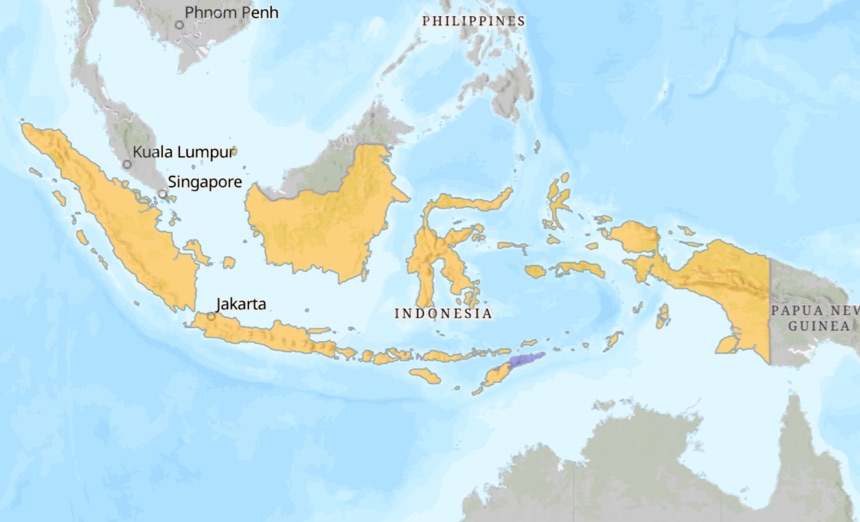Indonesia is affected by communal violence and local warlordism, as well as religious and ethnic cleavages.1 The country is also involved in a regional conflict against the United Liberation Movement for West Papua.2 Official statistics record one of the lowest rates of civilian gun ownership in the world, with occasional increases related to outbreaks of violence in parts of the country.3
In terms of weapons and ammunition management, Indonesia’s firearms regulation is considered restrictive, but the country is not party to most international treaties and protocols on weapons control.4
1 “Indonesia SSR Snapshot,” DCAF – Geneva Centre for Security Sector Governance, January 2, 2015, https://issat.dcaf.ch/Learn/Resource-Library/Country-Profiles/Indonesia-SSR-Snapshot.
2 Richard Chauvel, “West Papua: Indonesia’s Last Regional Conflict," Small Wars & Insurgencies 32, no. 6 (2021): 913-944, DOI: 10.1080/09592318.2021.1990491.
3 International Crisis Group, Illicit Arms in Indonesia (Jakarta/Brussels: International Crisis Group, 2010), Policy Briefing, Asia Briefing No. 109, https://www.files.ethz.ch/isn/120922/B109%20Illicit%20Arms%20in%20Indonesia.pdf.
4 Philip Alpers and Michael Picard, Indonesia – Gun Facts, Figures and the Law (GunPolicy.org, Sydney School of Public Health, University of Sydney, 2022), https://www.gunpolicy.org/firearms/region/indonesia.
Launch the country dashboard
Further information
Accidental explosions
Since the Small Arms Survey began collecting data in 1979, four accidental explosions have been reported in Indonesia.
Table 1. Accidental explosions in Indonesia (1979–2021)
Year | Location | Owner/manager | Deaths | Injuries |
2019 | Srondol | State (police) | 0 | 1 |
2014 | Pondok Dayung Island | State (military) | 1 | 87 |
2009 | South Sumatra | State (military) | 0 | 0 |
1984 | Jakarta | State (military) | 15 | 200 |
Source: “Unplanned Explosions at Munitions Sites (UEMS) Database,” Small Arms Survey, updated December 15, 2021, https://smallarmssurvey.org/database/unplanned-explosions-munitions-sites-uems.
Cases of diversion
Several cases of diversion have been reported in Indonesia, at least three of which included ammunition.
Table 2. Cases of diversion of arms, ammunition and explosives in Indonesia
Year | Location | Description |
2010 | Aceh | Two police officers in charge of the logistics department of police headquarters were arrested for selling 28 weapons and 20,000 rounds of ammunition originating from a police warehouse to a jihadi group.1 |
2010 | Solo (Central Java) | A former soldier and armoury guard, who was discharged from the military after being suspected of running a jihadi training camp, reportedly stole ammunition during military exercises. A cache with ammunition originating from military stockpile was found when the soldier’s barrack was searched.2 |
2000 | Tantui | An islamic militant raided a paramilitary police armoury and stole 660 handguns, 217 shoulder arms and 115 automatic rifles, which were later used in attacks against the police.3 |
2000 | Cikole | Two men stole an unspecified number of weapons and a few dozen rounds of ammunition from the Brimob arms depot, which they were responsible for guarding.4 |
1 International Crisis Group, Illicit Arms in Indonesia, p. 9.
2 International Crisis Group, Illicit Arms in Indonesia, p. 9.
3 International Crisis Group, Illicit Arms in Indonesia, p. 10.
4 International Crisis Group, Illicit Arms in Indonesia, p. 9.
Disposal
Insufficient information on the disposal of ammunition in Indonesia.
Needs
To further enhance safe and secure ammunition management, the following needs have been identified for Indonesia:
- Development or refinement of standards and procedures on stockpile management; and
- Capacity development for the destruction of surplus stockpiles.
Source: Indonesia, National Report on the Implementation of the Programme of Action on Small Arms and Light Weapons (PoA) and the International Tracing Instrument (ITI), (New York: Permanent Mission of Indonesia to the UN, 2020).



